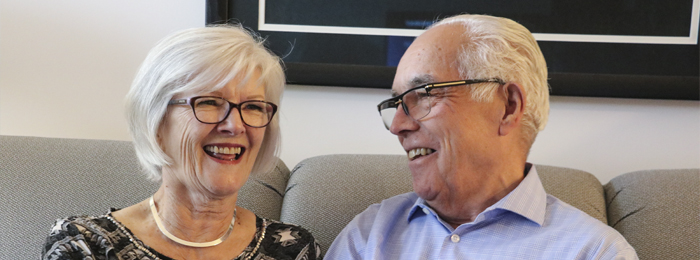
Meet Betty and Myron Pinnell
Today’s older adults are living longer; as a result, we see higher rates of dementia and other chronic conditions. Moreover, this growing and influential demographic is challenging commonly accepted assumptions about the inevitable path to assisted living or long-term care. People are telling us that they want to age in the comfort of their homes. Bruyère is listening.
Betty, 74 years old, and Myron, 77 years old, have called many cities in Canada home. When Myron was diagnosed with dementia and Betty started to see signs that they needed additional support — no longer following daily routines and not remembering familial details — they decided to move to Bruyère Health Village, which has 227 independent and assisted living units, to be closer to their children.
Since moving here a year and a half ago, they've already participated in a 12-week research study that is testing smart technology in the home.
Bruyère is home to an onsite smart apartment* where researchers and industry are collaborating and testing technologies to help older people remain independent and at home longer. A recently established collaborative** is taking innovation at Bruyère out into the community to the homes of people like Betty and Myron.
The system being developed detects and addresses wandering behaviour, a symptom of dementia, with the aim of supporting the person with dementia and helping relieve caregiver stress. It incorporates a series of visual and verbal cues, such as directional lighting and personalized voice recordings that can direct an individual back to bed when the wandering behaviour could be dangerous, opening the front door to leave the house, for example.
For the caregivers of people with dementia, nighttime is challenging — knowing that at any point your loved one is prone to getting up and could wander, possibly leaving the safety of your home.
Even though Myron had yet to wander, Betty started leaving a chair with a stack of boxes propped up against the front door, hoping if he did, the disruption could wake her.
Betty said she was happy to participate in the study because it involved installing a sensor that would sound an alarm and initiate an audio cue if the front door opened at night. With the system installed, she was reassured and was surprised by and thankful for how easy it was to install.
The system was removed when the research was completed.
“For the first couple of nights [after the system was taken out] when I went to bed, I just kind of thought, ‘oh, gee that’s not on there tonight, hope everything is ok.’ It just gives you peace of mind and comfort,” Betty said, following their participation in the study.
This technology has the potential to take the burden off the caregiver — something every caregiver can appreciate. It does the work of monitoring and getting the person back into bed — only waking the caregiver by an alarm or a text message if the person with dementia makes it to the front door.
The technology provides relief, safety and independence at home, for the caregiver and the person with dementia, and could ultimately delay entry to long-term care.
*The AGE-WELL SAM 3 (Sensors and Analytics for Monitoring Mobility and Memory) National Innovation Hub, a collaboration among Bruyère, Carleton University, and AGE-WELL NCE
**The AGE-WELL SAM 3 research partnership in collaboration with Bruyère, Carleton University, Champlain LHIN IMPACTT Centre, and the Dementia Society of Ottawa and Renfrew County